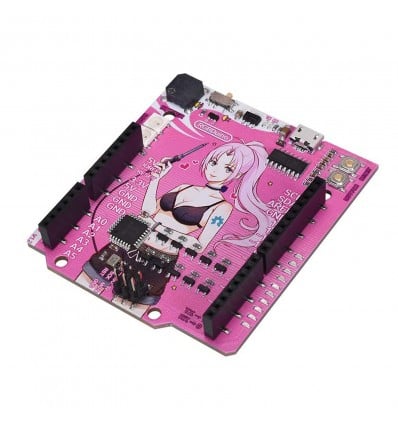International shipping Secure payment
No products
Prices are tax included
Product successfully added to your shopping cart
There are 0 items in your cart. There is 1 item in your cart.
The RGBDuino UNO Jenny is a specialised UNO R3 designed to make learning about Arduino and microcontrollers both easy and fun for everyone.
This product is no longer in stock
Free shipping on orders over R1250 - courier delivery and within South Africa
Learning about Arduino and how microcontrollers work is quite an enjoyable challenge, but as any experienced Electronics Maker will know, it’s not necessarily easy, but this is precisely what makes it so rewarding when you finally get your first couple of projects working in just the right way. However, while we must admit that we do enjoy the challenge that learning about Arduino brings, we also feel that it could be much easier, especially if we want more Makers to take up the hobby and get involved in creating awesome projects. This is why we often jump at the opportunity for goodies like the RGBDuino UNO V1.2 Jenny, as this fun little board is designed to act just like an original Arduino UNO, but has been enhanced with some extra features that make it both easier to use than normal, as well as more enjoyable to work with.
What Makes the Arduino UNO V1.2 Jenny Better for Learning?
Compared to a standard Arduino UNO R3, the UNO Jenny offers a few really cool improvements that really enhance the functionality of the standard UNO design, as well as a few minor upgrades that simply add to the convenience and ease of use of the board as well. So let’s take a quick look at some of these key features that we like the most:
- Programmable RGB LEDs – Although there have been a few microcontrollers that we’ve experimented with that included an onboard RGB LED for prototyping and onboard indications, these types of extras are typically reserved for higher quality (and higher priced) microcontrollers. However, the addition of two RGB LEDs on a basic Arduino, while typically being considered overkill, makes learning about RGB LEDs and programming them much easier, as users don’t have to prototype an entire circuit just to experiment with them. This dramatically speeds up the learning process involving coding without worrying about circuitry, giving users a headstart in development before committing to actually prototyping full circuits with calculated resistors and other unnecessary complications.
- Integrated MOSFET Circuits – As many Arduino users will understand, it’s typically considered best practice to avoid driving any power-hungry components directly from the pins, and transistors are often used to remedy that problem. However, using transistors is not easy for a beginner, and can easily just add extra confusion to the learning process, and that’s why we love the built-in MOSFETs that help this board drive components like LEDs, Motors and other potentially high-draw parts. Now, instead of having to create a specialised circuit just to ensure the safety of the board and pins, users can simply plug and play as they see fit without having to integrate transistors or separate power supplies, and while focusing on just learning the code and how to manipulate those electrons in just the right ways.
- Onboard Buttons & Passive Buzzer – In a similar fashion to the RGB LEDs, the RGBDuino UNO Jenny also offers a programmable button and an onboard passive buzzer, which is ideal for learning about user-based interactions in Arduino, while also adding extra stimulation with audio elements as well. With these, in addition to the RGB LEDs, you can create an entire project without ever having to solder, use a breadboard, or even use jumper wires between pins. From lighting to audio and some user interaction in between, users can build almost any basic project as they learn to code, learn how components interact with each other, and of course how users can get involved with direct user-to-Arduino interfacing.
- Many Minor Improvements – In addition to those major improvements mentioned above, some of the extra additions of the RGBDuino Jenny include a convenient Micro USB interface rather than the larger and clunkier USB-B interface, numerous tiny LEDs all over the front of the board that indicate when power, pins or other components are working, clear labelling for almost every pin and interactable component on the board, as well as a fun silkscreen design that even gives some space on the back for users to write their name and claim their projects as their own. These minor improvements don’t necessarily add to the functionality of the board, but certainly do assist with learning and understanding Arduino better, giving users insights into what’s actually going on with their Arduino UNO board, and making the entire learning process easier and more enjoyable too.
As you may notice, the RGBDuino Jenny is extremely similar to a standard Arduino UNO R3, but of course offers a load of minor and major extras that really help users understand more about Arduino and coding without committing to actual prototyping. This makes it an excellent starting point for anyone who wants to learn, but also for veterans who may be able to take advantage of all of these extras for their own projects. And in terms of value for money, these Arduino Boards are actually very affordable given the extra part count and clever design work that has gone into them, and whether you’re just starting out, are looking to advance your skills, or simply like the idea of integrated components on your Arduino, we recommend that anyone and everyone should take advantage of this clever and well-engineered RGBDuino Jenny.
Please Note: Because of the unique design and use of the CH340G IC to interface with the ATMega328P MCU, this board will require CH340G drivers, which can be found in the GitHub page listed at the bottom in the “Additional Resources” section.
RGBDuino UNO V1.2 Jenny - Technical Specifications: |
|
|
– RGBDuino |
|
|
|
|
|
– 5V DC via Micro USB |
|
– 14 (0 to 13) |
|
– 6 (A0 to A5) |
|
– D3 | D5 | D6 | D8 | D9 | D10 | D11 |
|
– 10 x I/O Pin LED Indicators – 3.3V & 5V LED Indicators – TX/RX Status LED Indicators |
|
– 2 x RGB LEDs – 1 x Functional Button |
|
– 1 x Passive Buzzer – 1 x Audio Toggle Switch – 1 x USB-A to Micro USB Cable Included |
|
– 32KB |
|
– 2KB |
|
– 1KB |
|
– 16MHz |
|
– ±22g |
|
– ±68 x 53.4 |
Additional Resources:
- If you want to get involved in the fun and see updates, news and other resources from the awesome manufacturers of these fun boards, we suggest following the RGBDuino Twitter Profile, where they share videos from interact with Makers and share helpful videos and other resources.
- Next up, if you’re eager to get a better understand of this board and how it operates, check out the official RGBDuino GitHub Page, where you can find drivers for the CH340G IC, example code, the user manual in PDF form, and more.
Finally if you want to see a fun visual demonstration of what these boards are capable of, check out the following RGBDuino Review by Another Maker. Bear in mind that, while he is reviewing the Duck variation of the board, both the Duck and the Jenny variants behave in exactly the same way. Rest assured, however, that we will hopefully be getting the Duck version in soon, but until then we do think the Jenny is a nice board, even if it doesn’t quite match the style of all users:
No customer reviews for the moment.
As one of the rising stars in the world of 3D Printer Component Research and Development, BigTreeTech have certainly hit the ground running, entering the market in 2015 and spending their early stages primarily learning, researching, testing and developing, before producing some truly impressive results. From simple but effective upgrades to standard parts, all the way through to completely custom parts that no other brand offered at the time, BigTreeTech now have an incredibly diverse range, with almost no area of 3D Printing being left out.
Some of BigTreeTech’s most notable additions to the world of 3D Printing include the SKR Motherboard Range for numerous different 3D Printer models, the awesome TFT Touch Display Range with fancy features like dual-mode operation, as well as their very impressive Stepper Driver Range that cater to all tastes and preferences under the sun. And of course, to top it all off, BigTreeTech also have a sister company named BIQU, and we must admit that they have been producing some pretty impressive (and low price) 3D Printers, with the BIQU B1 possibly becoming a new rival to the Ender 3.
Of course, it’s easy to see that BigTreeTech are modern masters of 3D Printing R&D, and while we do still have a lot of different parts that we want to test out from them, so far we’ve been extremely happy with what they’re capable of producing – all while fitting into same kind of hobbyist budget that they used to operate on as Makers and Tinkerers themselves.









